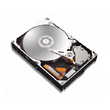| |
|
|
 |
 |
Background
Hard disks always have been and will remain the slowest parts in computers
due to their mechanical nature. Compared with a pure electronic
part, like memory, an electromagnetic part like the hard disk is
very, very slow; RAM speeds are measured in nanoseconds, hard disk
speeds in milliseconds. On the plus side, hard disks have increased
in size and several hundreds of GB are possible in the average
home PC. Some may also argue that technical
improvements have increased the MTBF (Mean Time Between Failure)
i.e. provided increased reliability, and that advances in technologies like
Fluid Dynamic Bearing have reduced the noise drives generate.
There
is one thing, however, that hard disks just haven't done very well on -
speed. Today's buzz words like UDMA, SATA etc. haven't made a 266 MHz-to-3.6 GHz type of
leap in performance. True, disks are faster now than ever before
but, relative to
advances in CPU architecture, hard disks are advancing at a very
leisurely rate. In terms of
metrics all they've done is move from 5400 rpm to 7200 rpm
on the spindle speeds and from 2 MB to 8 MB of onboard cache - and
that's it.
The storage space has increased tremendously
over time and the cost has deceased to less than
$1.00 per GB, a figure that would have been simply unbelievable as
little as two years ago. (There are downsides to larger sizes, of
course, in that the more the data you have on your platter the
longer it takes to find any one part of that data).
All
of the main hard disk manufacturers today, such as Maxtor, Western
Digital, Seagate, and Hitachi/IBM, offer near identical 7200rpm 8mb
cache PATA UDMA133 /SATA UDMA 150 hard disks. The products
vary only slightly in factors such as heat output, noise
generated, and warranty.
There is one exception,
the Western Digital Raptor, an enthusiasts' drive that has
received rave reviews. The Raptor is optimistically referred to as
an "enterprise class"
drive because it spins at 10k rpm.
This offers faster read and write speeds and faster access
times than any 7200rpm drive.
 The Raptors are
available in only two sizes - 36.7GB and 74GB, and are often
compared to SCSI drives in performance. Enthusiasts even combine
them in RAID
0 configurations to push their performance past
many older SCSI drives. The Raptors are
available in only two sizes - 36.7GB and 74GB, and are often
compared to SCSI drives in performance. Enthusiasts even combine
them in RAID
0 configurations to push their performance past
many older SCSI drives.
Maxtor's new drive,
the DiamondMax 10 (sic) goes down a different route. Maxtor decided to
forsake faster spindle speeds to offer a doubling
of the onboard cache and, importantly, support for Native
Command Queuing.
The
increase in cache helps with the storage of I/O requests from the
controller and speeds up the user experience. Accessing the cache,
which runs at RAM speeds, is faster than accessing the disk
platters so the more the data that can be stored in cache the more
the benefit to be seen in many applications. Native
Command Queuing is a SATA command protocol offering increased hard
disk speeds. It involves a more
intelligent routing of the hard disk heads when they
have several bits of data to read. It minimizes the number of
times the platter has to spin for the heads to access all the data
requested and this reduces the latency. Officially, it is a
powerful interface/ disc technology designed to increase
performance and endurance by allowing the drive to internally
optimise the execution order of workloads.
How does the 16 MB
of cache and the NCQ feature of the new 7200 rpm DiamondMax 10
compare with today's top 10K rpm Raptor with 8 MB of cache? We
decided to take them for a, er, spin.
DiamondMax
10 specifications
|
|
This
article was first posted on Sept 23, 2022. Note
the copyright notice at the bottom of the page. We
do actively prosecute content thieves.
|
|
